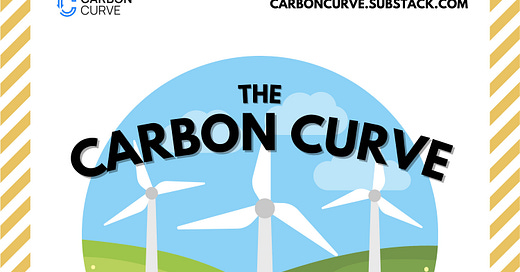Episode 13 of The Carbon Curve is with Dr. Cara Maesano, Geochemical Lead at RMI’s CDR Initiative
This episode is sponsored by Carbonfuture.
Carbonfuture is an end-to-end platform for companies who want to participate in removing carbon from the atmosphere. Unlike conventional marketplaces, Carbonfuture’s monitoring, reporting, and verification platform solves carbon credit uncertainty for buyers like Microsoft and SwissRe while Carbonfuture’s support helps scale the world’s most promising carbon removal ventures for real climate impact.
The core message of this podcast series is that the monumental task of removing gigatons of CO2 from the atmosphere is too big, too complex, and needs to happen too quickly for any one technology or stakeholder to solve alone.
That’s why I call carbon removal (or CDR) a collective action problem. Everybody has a unique and important role to play in scaling it up - from government, to entrepreneurs, to civil society.
What I learned in my previous career improving access to healthcare in some of the most underserved parts of the world is that sometimes depending on the organic growth of a suite of technologies is just not sufficiently fast enough to solve big, important, global imperatives. Like expanding access to vaccines or HIV medicines in low income countries … or massively scaling up CDR by 2050.
That’s why Dai Ellis - who has written some excellent thought pieces on this - advocates for intentionally shaping the CDR market we want, instead of accepting the CDR market as it is.
Roadmaps are one powerful organizing tool to accomplish this. If they’re done well, they can accelerate the scale up of public goods like CDR by mapping out the gaps in an ecosystem, prioritizing what needs to get done, and assigning responsibility to the right stakeholder groups.
It creates clarity and forward motion, and enables cross-sector collaboration. It charts a path for what it’s going to take to build an entirely new sector roughly the size of the global concrete industry.
That’s why I’m excited to speak to today’s guest - who co-developed a roadmap that spells out what it’s going to take to scale up geochemical carbon removal approaches to gigaton scale by mid-century. This roadmap is tremendously valuable in its own right, but is also useful as a blueprint for how to plan, organize, and mobilize stakeholders around scaling up other CDR pathways.
In this episode, Na’im and Cara discuss:
The definition of geochemical CDR
Why RMI developed this roadmap and why Cara thinks it will be useful and additive
How the roadmap was developed with the input of experts in the field
What the most critical building blocks are to get to megaton and gigaton scale for geochemical CDR
Some of the key bottlenecks to scaling up geochemical CDR and the overarching roles of major stakeholders in scaling it up
How this roadmap will be used and RMI’s plans to support the CDR space
Relevant links:
Geochemical Negative Emissions Technologies: Part II. Roadmap in Frontiers in Climate
Geochemical Negative Emissions Technologies: Part I. Review in Frontiers in Climate
Rock Solid by the Energy Futures Initiative and Innovation for Cool Earth Forum Roadmaps
About Cara:
Dr. Cara Maesano began her science career working in cosmology labs at UC Santa Barbara and Stanford University, building instrumentation for cosmic microwave background studies. She holds a PhD in Physics from UC Davis, where she helped to construct large underground particle detectors and studied interactions between cosmic rays and carbon atoms. As a postdoc, Cara focused on environmental exposure assessments and the impacts of air pollution, and climate change in general, on public health. The realities of the health impacts of climate change led her to switch her focus towards carbon removal as a solution, and she joined The Climate Map as a research scientist in Spring 2021. At RMI, she now leads efforts on technology assessments for Geochemical CDR and how they integrate into both the broader CDR ecosystem and the wider industrial landscape.
If you enjoyed this episode, please subscribe to this podcast on your favorite podcast app or subscribe via The Carbon Curve newsletter here. If you’d like to get in touch with Na’im, you can reach out via Twitter and LinkedIn.
Na’im Merchant, Founder and Managing Director of Carbon Curve, is an advisor and thought partner to start-ups, policy groups, and research organizations on scaling up climate technologies to meet the monumental challenge of removing billions of tons of CO2 from the atmosphere. Every week, Na’im will release a short interview with individuals advancing bold new ideas and taking a collective action approach to scaling up carbon removal.













Share this post